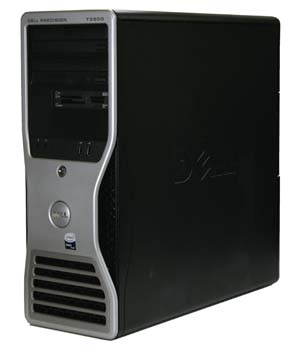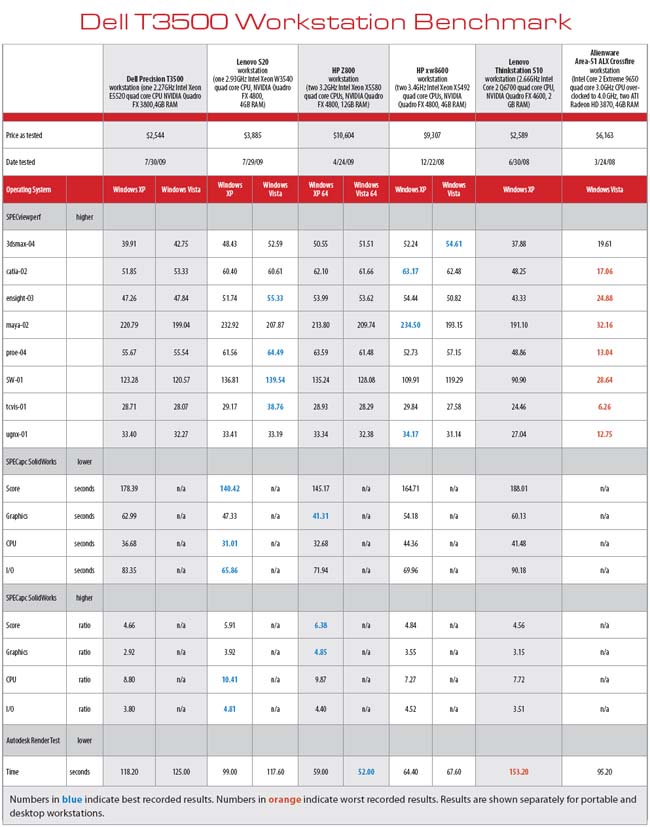Dell Precision T3500: Awesome Power at a Midrange Price
New Intel Nehalem microarchitecture-based CPUs come wrapped in a familiar package for a new workstation from Dell.
December 4, 2001
By David Cohn
 The Dell Precision T3500 workstation looks strikingly similar to earlier workstations, but is now equipped with a single Intel Xeon Nehalem-based quad-core CPU. |
It’s been nearly three years since we last reviewed a Dell Precision workstation, and needless to say, a lot has changed in that time. This time around, the Dell Precision T3500 that we received is powered by one of the latest Xeon processors, based on Intel’s Nehalem microarchitecture. The single-socket T3500 joins the Dell T5500 and T7500 in the latest refresh of the company’s Precision workstation lineup.
In spite of the passing of time, however, our evaluation unit bore a distinct resemblance to the much older Dell Precision 490 (see DE December 2006). The Precision T3500 comes housed in a similar gray and black case measuring 6.8 in. x 18.4 in. x 17.6 in. (WxDxH) and weighing in at 36 pounds. Although configured as a tower, the T3500 can also be reoriented as a desktop system.
The front panel provides two 5.25-inch drive bays that came filled with a pair of optical drives: a 16X DVD-ROM and a 16X DVD+/-RW drive. Below these, a smaller 3.5-inch flex bay contained a 19-in-1 media card reader. Down from there, a sloping panel contained microphone and headphone jacks and two USB ports, with cleverly concealed hard drive and network activity LEDs as well as four numbered diagnostic lights that help identify any problems during startup. The backlit power button is center just above the Dell medallion.
The rear panel houses a 9-pin serial port, a 25-pin parallel port, six USB ports, an RJ45 connector for the integrated Broadcom 5761 Gigabit Ethernet LAN, PS/2 mouse and keyboard connectors, audio-in and out, and an eSATA connector. Our evaluation did not include FireWire, which is available as an option.Like earlier Dell workstations we’ve reviewed, the Precision T3500 case opens on the right. Inside we found a similar unique hard-drive mounting system to the one we first encountered on the Precision 490. Up to two hard drives can be mounted on a special cage that hinges at the bottom of the case, and when latched in place, covers half of the motherboard, including the CPU, with its large passive heat sink. Two large cooling fans mounted in the front panel blow air over the CPU and memory sockets. For our purposes, Dell included a single 7200rpm 160GB Seagate Barracuda SATA drive, although larger and faster SATA and SAS drives are also available. The system supports RAID 0, 1, 5, and 10.
With the drive cage pivoted out of the way, we had easy access to both the processor and the six DIMM sockets, four of which were filled with 1GB 1333MHz DDR3 ECC memory modules. The Precision T3500 can accommodate up to 24GB of memory using 4GB DIMMs. While Dell offers Intel W3500 and W5500 series CPU options that range all the way up to 3.2GHz, our evaluation unit came with the much more sedate 2.27GHz Quad Core Intel Xeon W5520 processor.
 |
The Dell motherboard, based on the Intel X58 chipset, provides a total of six expansion slots: two PCI Express 2.0 x16 slots, two PCIe x4 slots, and two PCI card slots, as well as an internal USB connector. Our evaluation unit came with a single NVIDIA Quadro FX 3800 graphics accelerator installed in one of the PCIe x16 slots. This new high-end board contains 192 CUDA parallel processor cores and 1GB of GDDR3 memory and provides two DisplayPort connections as well as a single DVI port that supports Dual Link DVI. While the single-slot solution requires an auxiliary power connection, it leaves the other five expansion slots completely accessible. Dell offers the NVIDIA Quadro FX 4800 and ATI FirePro V8700 as more expensive options, or users can choose less expensive boards from both NVIDIA and ATI.
Dell Precision T3500 |
Power comes from a 525-watt power supply, although Dell offers an 85PLUS power supply as part of an extra-cost option that brings the system into Energy Star 5.0 compliance. In spite of four fans—two in the front panel, one in the power supply, and one on the graphics board—the system is virtually silent after startup.
Midrange performance Dell included two identical hard drives, so we could perform benchmark tests under both Windows XP and Windows Vista, and all of the results were very respectable. The Dell Precision T3500 easily outperformed older systems, although it lagged somewhat behind the most recent workstations we’ve looked at from HP and Lenovo, owing to Dell’s decision to send us a somewhat slower CPU and graphics accelerator. Still, the T3500 performed quite well on the SPEC viewperf tests.
On the SPECapc SolidWorks benchmark, which is more of a real-world test, the results were considerably slower, specifically because of the slower CPU. The same proved true for the AutoCAD rendering test—although here, thanks to hyper-threading, the results were still quite respectable. With eight threads, the Dell Precision T3500 took exactly twice as long to complete the rendering as the faster HP workstation, which benefited from the equivalent of 16 simultaneous processes.
Once we factored in the price, however, we are quite ready to excuse the slightly more modest performance. Prices for the Dell Precision T3500 start at $999, with our evaluation unit pricing out at just $2,544 (after applying a $150 discount currently available on the Dell website).
Like its competitors, Dell currently offers 32- or 64-bit versions of Windows Vista as well as downgrades to Windows XP, and qualified buyers can upgrade to Windows 7 for free once it becomes available. The T3500 is backed by a three-year basic warranty with next business day on-site service. Longer service contracts, direct end-user support with 4-hour 24/7 onsite response, accidental damage protection, data recovery protection, and a prepaid recycling service are all available as extra-cost options at the time of purchase. You can even pay Dell to plant a tree to offset the environmental impact of your new computer.Dell rounded out our evaluation unit with a cordless Multimedia Pro 105-key keyboard and mouse, although we would have been quite happy with a standard corded keyboard and mouse. Serious CAD users will probably want to configure their system with a faster CPU and bigger hard drive, and may consider splurging for an ultra high-end graphics card, but even when you add those options, the Dell Precision T3500 is still a very affordable midrange CAD workstation that packs an awesome amount of power.
More Info:
Dell
Contributing Editor David Cohn is DE’s MCAD and workstation expert. A computer consultant and technical writer based in Bellingham, WA, he has been benchmarking PCs since 1984. He’s the former editor-in-chief of Engineering Automation Report and CADCAMNet, and the author of more than a dozen books. Please send comments about this article to [email protected] or to [email protected].
Subscribe to our FREE magazine, FREE email newsletters or both!
About the Author
David Cohn is a consultant and technical writer based in Bellingham, WA, and has been benchmarking PCs since 1984. He is a Contributing Editor to Digital Engineering, the former senior content manager at 4D Technologies, and the author of more than a dozen books. Email at [email protected] or visit his website at www.dscohn.com.
Follow DE





